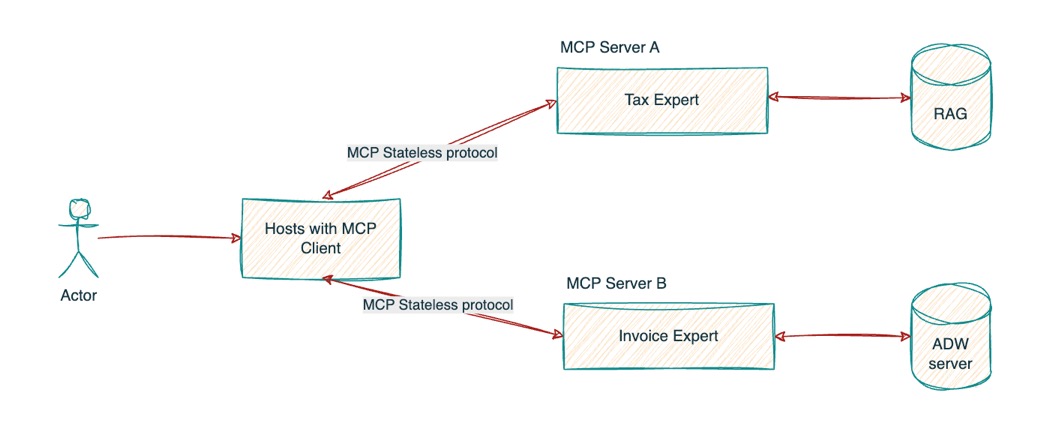Introduction
With the evolving enterprise landscape, organizations must process and analyze transaction data, invoices, and regulatory requirements with speed, accuracy, and auditability. Traditional batch pipelines and monolithic applications struggle to keep pace with evolving tax laws, diverse data formats, and the need for real-time insights. To address these challenges, our solution leverages a swarm-based Agentic AI architecture powered by the Model Context Protocol (MCP) framework.
A swarm refers to a group of more than two agents working collaboratively to achieve a common goal. These agents can be software entities, such as LLMs, that interact with each other to perform complex tasks and have dynamic and problem-solving capabilities.
MCP is an open protocol that standardises how applications provide context to LLMs. This is a standardised way to connect AI models to different data sources and tools. LLMs frequently need to integrate with data and tools, and MCP provides:
- A growing list of pre-built integrations that LLM can directly plug into
- The flexibility to switch between LLM providers and vendors
- Best practices for securing data within the customer infrastructure
For more details about MCP, please visit the MCP Introduction.
In this blog, we will examine a real-world example where multiple agents help to answer a query. Two specialized AI agents, which we term “experts”, operate in concert and support customer tax queries.
Use case: Agentic AI Swarm on MCP

Tax audit companies would need multiple information from multiple data sources, in order to create audit reports. In this diagram, Tax and Invoice information are reconciled to ensure tax reports created are auditable.
There are two AI experts, one for tax queries and information, and the other offers invoice-related tools, including GetDetails, GetMetadata, and more.
-
Tax Expert
- Capability: Uses Oracle Cloud Infrastructure’s Retrieval-Augmented Generation (OCI RAG) agent with country-specific taxation data, sitting atop a base LLM.
- Function: Dynamically queries up-to-date tax codes, regulations, and precedent cases to compute tax liabilities, generate compliance checklists, and surface optimal filing strategies.
- Integration: Exposes a simple tool interface backed by the MCP Server hosted on OCI Data Science as an HTTP endpoint, so that other agents can request tax calculations or regulatory excerpts on demand.
-
Invoice Expert
- Capability: Interfaces with an ADW(Oracle Autonomous Data Warehouse)-backed MCP Server tool, that maintains the organization’s invoice ledger and metadata.
- Function: Retrieves, aggregates, and normalizes invoice data—such as vendor totals, due dates, and line-item details—enabling precise downstream analysis.
- Integration: Publishes its outputs via MCP, making them immediately available to any other agent in the swarm.
Behind the scenes, OCI Cohere Manage Service orchestrates the “react” (ReAct) decision cycles—routing requests, managing state transitions, and ensuring each expert invokes the right tool at the right time.
Why Adopt MCP for Agentic AI?
Modularity & Scalability
- Each expert lives in their microservice, with clearly defined tool interfaces. Teams can independently update tax‐code logic or invoice schema without impacting the other agent.
- New experts (e.g., a “Credit Risk Expert”(an expert in determining credit risk) or “Audit Trail Expert”(an expert who provides an audit trail) ) can be onboarded rapidly by simply registering another MCP tool.
Real-Time Collaboration
- The MCP bus glues disparate services into a cohesive workflow. An analyst’s “What’s my tax liability on unpaid June invoices?” query triggers both the Invoice Expert (to fetch data) and the Tax Expert (to compute liability) in a seamless handoff, delivering answers in seconds rather than hours.
Maintainability & Governance
- Tool calls and data exchanges are logged and auditable at the MCP layer, supporting compliance and traceability requirements.
- Role-based access controls can be enforced at each microservice boundary, ensuring sensitive financial data remains protected.
Cost Efficiency
- By decoupling compute workloads, each service can autoscale independently on OCI, optimizing resource utilization and controlling costs.
- Teams only pay for the exact mix of container or function‐run time they consume, rather than over-provisioning a monolith.
Rapid Innovation
- With MCP’s plug-and-play model, business units can pilot new AI capabilities—such as invoice anomaly detection or predictive cash-flow forecasting—by adding lightweight experts, without touching the core pipeline.
Enabling MCP Server Streamable HTTP with Model Deployment
At OCI, Model Deployments are a managed resource in the Data Science service used to deploy machine learning models and extend to host MCP Servers as HTTP endpoints. Hosting in OCI Data Science enables AI applications and agents to securely access tools and data.
In the context of Model Deployment, MCP can be hosted as a middleware layer in the model serving pipeline. Clients can invoke HTTP inference endpoints wrapped in an MCP client. This client would negotiate session identifiers, propagate shared metadata, and optionally fetch historical context from a server. On the model server side, MCP handlers would parse and apply context during pre-processing, before forwarding the prompt to the LLM or fine-tuned model. Post-processing can also leverage context (e.g., user preferences) for formatting or filtering outputs.
With MCP embedded into Model Deployment, OCI can:
- Enable stateful, dynamic interactions with models.
- Improve prompt relevance and output coherence.
- Support enterprise use cases such as context-aware summarisation, contextual code generation, and session-based reasoning.
Conclusion
Adopting the MCP-based swarm architecture empowers finance and compliance teams to move from rigid, batch-oriented processes to a dynamic, real-time AI ecosystem. By decomposing domain logic into reusable expert agents—seamlessly coordinated by MCP and empowered by OCI’s RAG, Redis, ADW, and Cohere services—organizations unlock faster time-to-insight, stronger governance, and ongoing flexibility to evolve their AI capabilities as business needs change.


